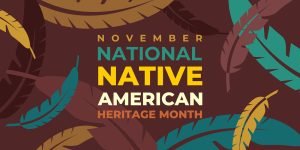
Native American Heritage Month was established in 1990 under President George H.W. Bush as a month set aside to commemorate and honor all Native American cultures. Today, there are 574 federally recognized tribes within the United States. Each one has its own traditions and languages. Native peoples are often viewed as historical figures, but I would like to remind you that we are still here. We are still practicing our traditions, speaking our languages, and sharing our cultures while participating in the broader American society.
During Native American Heritage Month, I am proud to represent the Yup’ik culture here in my home state of Arkansas, thousands of miles away from my family’s homelands of western Alaska. My grandmother was born in Hooper Bay, Alaska, one of 14 siblings. They lived a subsistence lifestyle, harvesting what they needed from the land and sea. Before she passed away this August, my grandmother shared stories with me and my sisters about berry picking, fish camp, and the importance of family.
Arkansas is no longer home to Native communities, although Native individuals like me call it home today. Arkansas was once the home of the Caddo, Osage, and Quapaw Indians and briefly housed a small group of Cherokees, known today as Old Settlers. When the Indian Removal Act of 1830 was enacted by Congress and signed into law by President Andrew Jackson, the resident tribes of Arkansas and the Southeast were forced to relocate to Indian Territory, present-day Oklahoma. Arkansas witnessed the removal of the Cherokee, Chickasaw, Choctaw, Muscogee, and Seminole peoples. You can learn more about this removal through the Sequoyah National Research Center’s Journey of Survival. You can also visit the Coleman Creek Trail of Tears Park at the south end of campus near where groups of Chickasaws and Choctaws camped on their way along the Southwest Trail, beginning in 1831 with the last groups traveling through in 1838.
Working in a research center dedicated to preserving American Indian and Alaska Native materials has allowed me to connect with my Native heritage in a way I did not expect. I am able to preserve materials that will not only result in scholarly publications but also draw families to stories that had been forgotten or were never known. This doesn’t happen only in the month of November, but all year long.
I want to encourage you to learn more about today’s contemporary Native peoples for yourselves, whether you pick up a copy of Pulitzer Prize-winning author N. Scott Momaday’s House Made of Dawn, read a poem by the 23rd Poet Laureate of the United States Joy Harjo, tune in to Oklahoma-based Reservation Dogs, listen to Grammy Award-winning Raven Chacon’s music, or get to know a Native person. We are all unique. We may even be a Yup’ik with a southern accent.
Quyana cakneq! Thank you very much!

Erin Fehr, Assistant Director of Sequoyah National Research Center and Archivist